Scunthorpe
| Scunthorpe | |
| St John's Church, Scunthorpe |
|
 Scunthorpe |
|
| Population | 65,163 (2011)[1] |
|---|---|
| OS grid reference | SE893102 |
| – London | 145 mi (233 km) S |
| Unitary authority | North Lincolnshire |
| Ceremonial county | Lincolnshire |
| Region | Yorkshire and the Humber |
| Country | England |
| Sovereign state | United Kingdom |
| Post town | SCUNTHORPE |
| Postcode district | DN15 – 17 |
| Dialling code | 01724 |
| Police | Humberside |
| Fire | Humberside |
| Ambulance | East Midlands |
| EU Parliament | Yorkshire and the Humber |
| UK Parliament | Scunthorpe |
|
|
Coordinates: 53°34′51″N 0°39′01″W / 53.5809°N 0.6502°W
Scunthorpe is a town in North Lincolnshire, England. It is the administrative centre of the North Lincolnshire unitary authority, and had an estimated total resident population of 65,163 according to the 2011 census. A predominantly industrial town, Scunthorpe, the United Kingdom's largest steel processing centre, is also known as the "Industrial Garden Town".[2][3] It is the third largest settlement in Lincolnshire after Lincoln and Grimsby. The Member of Parliament for Scunthorpe is Nic Dakin (Labour).
History
Scunthorpe as a town came into existence due to the exploitation of the local ironstone resources, and subsequent formation of iron works from the 1850s onwards. The regional population grew from 1,245 in 1851 to 11,167 in 1901 and 45,840 in 1941. During the expansion Scunthorpe expanded to include the former villages of Scunthorpe, Frodingham, Crosby, Brumby and Ashby. Scunthorpe became an urban district 1891, merged as 'Scunthorpe, Brumby and Frodingham Urban District' in 1919, and became a municipal borough in 1936.[4]
Etymology
The town appears in the Domesday Book (1086) as Escumesthorpe, which is Old Norse for "Skuma's homestead",[5] a site which is believed to be in the town centre close to where the present-day Market Hill is located.
Geology

Scunthorpe is located close to an outcrop of high-lime-content ironstone (~25% iron average) from a seam of the Lias Group strata which dates from the Early Jurassic period and runs north-south through Lincolshire. Ironstone was mined by opencast methods from the 1850s onwards, and by underground mining from the late 1930s. In the 1970s the steel industry in Scunthorpe transitioned to use of ores imported from outside the UK with higher iron content. Underground mining in the area ceased in 1981.
Scunthorpe was close to the epicentre (this was centred at Middle Rasen) of one of the largest earthquakes experienced in the British Isles on 27 February 2008, with a magnitude of 5.2. Significant shocks were felt in Scunthorpe and the surrounding North Lincolnshire area. The main 10-second quake, which struck at 00:56 GMT at a depth of 9.6 mi (15.4 km), was the second largest recorded in the British Isles. In 1984 a quake with a magnitude of 5.4 struck north Wales.
Government

Scunthorpe forms an unparished area in the borough and unitary authority of North Lincolnshire.[6] The town forms six of the borough's seventeen wards, namely Ashby, Brumby, Crosby & Park, Frodingham, Kingsway with Lincoln Gardens and Town. The Scunthorpe wards elect 16 of the borough's 43 councillors. As of 2008, all are members of the Labour party.[7] The councillors form the charter trustees of the Town of Scunthorpe and they continue to elect a town mayor.[8]
North Lincolnshire Council is based in Pittwood House off Ashby Road (former A159) next to Festival Gardens. It opened in 1963 as the Civic Centre, and was the home of Scunthorpe Borough Council until 1996. It was named after Edwin Pittwood, a local Labour politician, who worked in the opencast ironstone workings near Normanby Park. There are also offices at Church Square House near the Scunthorpe Market. Pittwood House has since been renamed as Civic Centre due to the relocation of the Register Office from its old premises in Oswald road.
Civic history
Historically part of Lincolnshire, in 1889 the area was included in the Lincolnshire, Parts of Lindsey administrative county. Separate local government began in 1890 when the Scunthorpe local board of health was formed. In 1894 the local board was replaced with an urban district council. Ten years later the neighbouring townships of Brumby and Frodingham (including Crosby) were also constituted an urban district. The two urban districts were amalgamated, along with the parish of Ashby in 1919 to form a new Scunthorpe urban district. Scunthorpe received a charter incorporating the town as a municipal borough in 1936.[9]
Local authority boundary changes brought the town into the new county of Humberside in 1974, and a new non-metropolitan district, the Borough of Scunthorpe was formed with the same boundaries as the old municipal borough. The opening of the Humber Bridge on 24 June 1981 provided a permanent link between North and South Humberside but did not secure Humberside's future. To the relief of its many detractors, the county of Humberside (and Humberside County Council) was abolished on 1 April 1996 and succeeded by four unitary authorities.
The previous Humberside districts of Glanford and Scunthorpe, and that part of Boothferry district south of the northern boundaries of the parishes of Crowle, Eastoft, Luddington, Haldenby and Amcotts, now compose the unitary authority of North Lincolnshire.[6] On amalgamation charter trustees were formed for Scunthorpe,[8] and they continue to elect a town mayor.
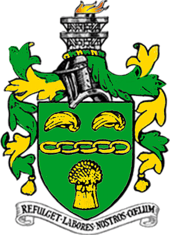
Coat of arms
When Scunthorpe was incorporated as a borough in 1936, it also received a grant of a coat of arms from the College of Arms.[10] These arms were transferred to the new borough council formed in 1974,[11] and are now used by the town's charter trustees.
The green shield and golden wheatsheaf recall that the area was until recently agricultural in nature. Across the centre of the shield is a length of chain. This refers to the five villages of Crosby, Scunthorpe, Frodingham, Brumby & Ashby linking together as one. At the top of the shield are two fossils of the species Gryphaea incurva. These remains of oysters, known as the "devil's toenails", were found in the rock strata from which ironstone was quarried. The crest, on top of the helm, shows a blast furnace. This is also referred to in the Latin motto: Refulget labores nostros coelum or The heavens reflect our labours popularly attributed to the glow observed in the night sky from the steelmaking activities.[12]
Geography
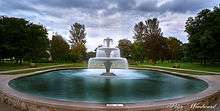

Scunthorpe lies on an escarpment of ridged land (the Lincoln Cliff) which slopes down towards the Trent. The surrounding environs are largely low-lying hills and plains. Although the town itself is heavily industrial it is surrounded by fertile farmland and wooded areas. In terms of general location it lies a mile east of the River Trent, 8 miles (13 km) south of the Humber Estuary, 15 miles (24 km) west of the Lincolnshire Wolds and 25 miles (40 km) north of Lincoln. The town is situated at the terminus of the M181, 42 miles (68 km) from Sheffield. Nearby towns and cities are Hull (18 miles northeast), Doncaster (20 miles west), Grimsby (22 miles east) and York (46 miles northwest). From its position at the heart of North Lincolnshire it is roughly 5 miles (8.0 km) south/south-east to Lincolnshire proper, 10 miles (16 km) west to South Yorkshire, 8 miles (13 km) north by northwest to the East Riding of Yorkshire and 15 miles (24 km) east to North East Lincolnshire
Climate
Like most of the United Kingdom, Scunthorpe has an oceanic climate (Köppen: Cfb).
| Climate data for Scunthorpe | |||||||||||||
|---|---|---|---|---|---|---|---|---|---|---|---|---|---|
| Month | Jan | Feb | Mar | Apr | May | Jun | Jul | Aug | Sep | Oct | Nov | Dec | Year |
| Average high °C (°F) | 5.8 (42.4) |
6.1 (43.0) |
8.9 (48.0) |
11.4 (52.5) |
15.2 (59.4) |
18.4 (65.1) |
20.3 (68.5) |
20.1 (68.2) |
17.7 (63.9) |
13.8 (56.8) |
8.9 (48.0) |
6.5 (43.7) |
12.8 (55.0) |
| Average low °C (°F) | 0.6 (33.1) |
0.5 (32.9) |
1.9 (35.4) |
3.6 (38.5) |
6.5 (43.7) |
9.5 (49.1) |
11.4 (52.5) |
11.4 (52.5) |
9.5 (49.1) |
6.8 (44.2) |
3.2 (37.8) |
1.4 (34.5) |
5.5 (41.9) |
| Average precipitation mm (inches) | 48 (1.9) |
38 (1.5) |
48 (1.9) |
48 (1.9) |
51 (2.0) |
53 (2.1) |
53 (2.1) |
64 (2.5) |
48 (1.9) |
48 (1.9) |
56 (2.2) |
53 (2.1) |
610 (24.0) |
| Source: [13] | |||||||||||||
Economy
Steel industry
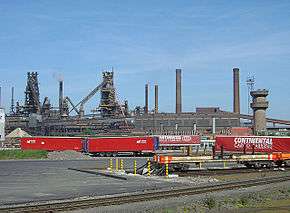
The Iron industry in Scunthorpe was established in the mid 10th century, following the discovery and exploitation of middle Lias ironstone east of Scunthorpe. Initially iron ore was exported to iron producers in South Yorkshire. Later, after the construction of the Trent, Ancholme and Grimsby Railway (1860s) gave rail access to the area iron production in the area rapidly expanded using local ironstone and imported coal or coke. Rapid industrial expansion in the area led directly to the development of the town of Scunthorpe, eventually incorporating several other former hamlets and villages, located in a formerly sparsely populated entirely agricultural area.
From the early 1910s to the 1930s the industry consolidated, with three main ownership concerns formed - the Appleby-Frodingham Steel Company, part of the United Steel Companies; the Redbourn Iron Works, part of Richard Thomas and Company of South Wales (later Richard Thomas and Baldwins); and John Lysaght's Normanby Iron Works, part of Guest, Keen and Nettlefolds.
In 1967 all three works became part of the nationalised British Steel Corporation (BSC), leading to a period of further consolidation - from the 1970s the use of local or regional ironstone diminished, being replaced by imported ore via the Immingham Bulk Terminal. Both the Normanby Park and the Redbourn works closed in the early 1980s. Conversion to the Linz-Donawitz process ( or "basic oxygen" process) of steel making from the open hearth process took place from the late 1960s onwards and was complete by the 1990s.
Following privatisation in 1988, the company together with the rest of BSC became part of Corus (1999), later Tata Steel Europe (2007). In 2016 the long products division of Tata Steel Europe was sold to Greybull Capital with Scunthorpe as the primary steel production site.
As of 2012 the steel industry is the major employer in the area and the largest operator within it is Tata Steel Europe; the number employed in the industry fell from 27,000 at its height to around 4,500 (excluding outside contractors) by the mid 2010s. In addition to being a major employer the works and former ironstone workings have or have had large scale environmental effects, including air pollution and subsidence.
Industries associated with the steelworks include metal engineering as well as a BOC plant.
Other industries
The historical predominance of the steel industry made Scunthorpe a virtual monotown; other industries in the town do exist. They include food production, distribution and retailing. North of the town next a waste management firm, Bell Waste Control, which services the majority of industry in Scunthorpe and the surrounding areas. On the Foxhills Industrial Park, north of the A1077 northern bypass, are many distribution companies, notably a large building owned by the Nisa co-operative type mutual organisation which has its UK headquarters there. Also on the Foxhills Industrial Park is a 500,000 square foot factory occupied by Wren Kitchens, employing 350 full-time workers.[14]
2 Sisters Food Group have a large chicken processing plant in the town. Key Country Foods produces meat products on an industrial scale. The Sauce Company produces sauces, soups and other foodstuffs for the catering and supermarket sectors. Ericsson Mobile Platforms produces printed circuit boards for the telecommunications industry. There are a number of other firms, mostly involved in manufacturing and light engineering.
In the 2001 census 19.3% of the working age population were economically inactive.[15]
Retail
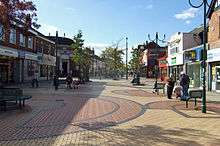
Scunthorpe has two major shopping centres, effectively a single site: the Foundry Shopping Centre and the Parishes Centre. The former was constructed in the late 1960s/early 1970s during a wholesale reconstruction of the old town; the latter was constructed in the early part of the 2000s decade on the site of the town's old bus station. There are also many well known retailers on High Street.[16][17] On 6 January 2011 Marks and Spencer closed their High Street store after 80 years of trading in the town,[18] but a new Marks and Spencer store opened near the football ground in 2014.
However the size of the remaining retail units reflects the size of the area's population and with larger shopping facilities within reasonable travelling distance in Grimsby, Hull, Doncaster, Lincoln, Leeds and at Meadowhall Centre, Sheffield many locals often travel to these towns for major purchases.
All the big food retailers are represented in the area; There is a Tesco Extra opposite the football ground, while Sainsbury's (formerly a Safeway) have their store on the site of the old Scunthorpe United stadium, The Old Show Ground. Morrisons have a store at the bottom of Mortal Ash Hill (known locally as "Motlash") (A18 road) at the Lakeside Retail Park, on the eastern entrance to the town, while Asda have a store on Burringham Road[19] In 2011 Asda opened another store in the former Netto, on Charlton Street.
In October 2014 Marks and Spencer's returned to the town after almost a 4-year absence. The store is housed in a purpose built location at the North Lincolnshire Shopping Centre, beside Glanford Park. Debenhams, Boots, Costa Coffee and Subway have also opened stores at the centre.
Transport
Scunthorpe railway station lies on the South TransPennine Line which has trains from Manchester Airport to Cleethorpes. The town lies five miles (8 km) north of the M180. Before this motorway was opened in 1979, all the east-west goods traffic took the A18 to Grimsby. Humberside Airport is a short drive to the east along the M180. The town's bus station is off Fenton Street. The bus station is predominantly used by Stagecoach in Lincolnshire, that operate services within and out of the town, followed by Hornsby Travel.
Religion
The church of St John the Evangelist, in Church Square, was completed in 1891 and consecrated on 15 April that same year. The church was built, at a cost of £20,000 (equivalent to £1,970,000 as of 2015) on land given by Lord St Oswald.
Built of Frodingham ironstone, and comprising a nave with five bays and a clerestory, a chancel, north and south aisles, two porches and a tower, it could accommodate up to 500 worshippers. It was designed by J. S. Crowther in the perpendicular style. The original striking clock was installed, in 1890 by William Potts and Sons of the Guildford Clock Works in Leeds. In 1897 quarter chimes were added. The peal of eight bells were hung in 1893, in memory of the Lord St Oswald. The organ, built in London, cost £1,000.
The final church service was held on 29 April 1984[20] and the building is now an arts centre.
Culture

The North Lincolnshire Museum is on Oswald Road, near the railway station.[21] The former church of St John the Evangelist is now the 20–21 Visual Arts Centre.[22] The Plowright Theatre, named after Joan Plowright, is on Laneham Street (off the west end of High Street and also near the railway station). It was built in 1958 as Scunthorpe Civic Theatre.[23] The Baths Hall, reopened in 2011, a 1,700 capacity venue also hosts visiting musical and theatrical events.[24]
The Scunthorpe Co-operative Junior Choir from Scunthorpe won the title of BBC Radio 3 Choir of the Year 2008 at the Grand Finals on 7 December 2008 at the Royal Festival Hall, London. The main choir is made up of 90 members aged between 9 and 19 years whilst also having two training choirs taking children as young as 3 years old. They have made several CDs, perform numerous concerts in the area and further afield, have been subject of documentaries and are internationally renowned as having travelled the world.[25]
Media and entertainment
Television
- Estuary TV broadcasting via Freeview Channel 8 is part of the Government's network of local community Channels.
Radio
- Viking FM broadcasts on 96.9 FM from Kingston upon Hull, having some of its coverage given to North Lincolnshire, which includes Scunthorpe;
- Lincs FM broadcasts on 102.2FM from Lincoln, covering the whole of Lincolnshire including the Scunthorpe area.
- BBC Radio Humberside is broadcast on 95.9 FM from Kingston upon Hull, with its coverage given to the old county of Humberside, now including the East Riding of Yorkshire and all of North & North East Lincolnshire & all Lincolnshire at certain times. Coverage often includes broadcasts of local football team Scunthorpe United;
- BBC Radio Lincolnshire broadcast from Lincoln, its coverage covering the entire current county of Lincolnshire.
Regional news programmes
- BBC Look North broadcast by the BBC from Queen's Gardens in Kingston upon Hull with news offices in Grimsby, covering the East Riding of Yorkshire and North & North East Lincolnshire;
- Calendar, broadcast by ITV Yorkshire from Leeds, West Yorkshire with a local crew based in nearby Grimsby, covering all of the boroughs of Yorkshire and Lincolnshire.
The local newspaper is the Scunthorpe Telegraph (formerly the Scunthorpe Evening Telegraph) with an online version at www.scunthorpetelegraph.co.uk.
Venues
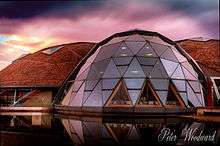
Scunthorpe has a leisure centre (The Pods) next to Pittwood House, museum, galleries, craft centres, several clubs, pubs and bars, a Vue multiplex cinema adjacent to the bus station. The Baths Hall in Doncaster Road was a popular music venue, before it was closed because of the costs of bringing the building up to scratch, and dealing with industrial contamination on site. The Labour Council prevented the Baths from being demolished in 2007 and commenced a major rebuild of the venue, which has involved demolishing all but the facade of the building. The building re-opened in November 2011.
Education
Scunthorpe's primary schools include Berkeley Junior School, Brumby Junior School, Crosby Primary School, Frodingham Infant School, Oasis Academy Henderson Avenue, Oasis Academy Parkwood, St Augustine Webster's Catholic Voluntary Academy, St Bernadette's Catholic Primary Voluntary Academy, St Peter and St Paul CofE Primary School, Scunthorpe CofE Primary School and Westcliffe Primary School.
Secondary schools within Scunthorpe include Outwood Academy Brumby on Cemetery Road, and Outwood Academy Foxhills on Foxhills Road. Frederick Gough School is to the south of the town in Bottesford. Melior Community Academy, to the east of the town, was formed by the merger of South Leys Business & Enterprise College on Enderby Road and Thomas Sumpter School. St Bede's Catholic Voluntary Academy on Collum Avenue is the main Roman Catholic secondary schools for the area, while the St Lawrence Academy on Doncaster Road is a Church of England secondary school in the town. It was formerly known as High Ridge Specialist Sports College and became the town's first academy opening on 1 September 2008. Humber UTC opened in 2015 and is a university technical college for pupils aged 14 to 19. St Hugh's Communication and Interaction Specialist College,[26] is a school for pupils aged 11–19 with moderate to complex learning needs associated with physical and social problems.
Scunthorpe currently has two study support centres, Study United FC and Study Heslam set up with funding from the government's Playing for Success scheme. These are based at Glanford Park, the home of Scunthorpe United Football Club and Heslam Park, home of Scunthorpe rugby & cricket clubs.[27]
Further education
John Leggott Sixth-Form College (JLC) on West Common Lane. North Lindsey College is close by on Kingsway (A18).
On 30 November 2010, as part of the 2010 UK student protests students and members of the public joined a series of nationwide outside John Leggott College. The protest was against the Parliamentary plans to increase University tuition fees.[28]
Law and order
The area is served by Humberside Police. According to Home Office data the area has crime rates higher than the national average, especially in the categories of violence against the person, sexual offences, burglary and theft of motor vehicles.[29]
Sport
Football
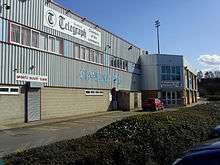
The town has a Football League club, Scunthorpe United (nicknamed "The Iron") who play at Glanford Park. For most of its existence in the professional game (since only 1950) it has been in the basement league of the English game. At the end of the 2006–7 season they won promotion to the Football League Championship as champions of League One, amassing a total of 91 points, being promoted at home to Huddersfield Town: having been top since January: despite being outsiders for a considerable amount of that time, and being promoted with 3 games to spare. This being the first time they have played at this level for 44 years. This was to last just one season as the club were relegated on 12 April 2008, with three games to spare, away to Crystal Palace. However, they returned to the Championship after one season, winning the League One playoffs in May 2009.[30]
In the last financial year for which accounts are available (the year ending June 2009) the club made a loss of over £1,500,000 with turnover down by over 17%.
Kevin Keegan and Ray Clemence both played for Scunthorpe United in the early 1970s before being signed for Liverpool. Former England cricket captain Ian Botham played a number of games for the club, being a resident of nearby Epworth at that time and in an attempt to keep fit during the winter months. The team mascot is called the "Scunny Bunny".[31]
Local teams play in the Scunthorpe & District Football League.
Rugby
Scunthorpe Rugby Club[32] play in the National League 2 North, the fourth tier of the English rugby union system. Their home ground is at Heslam Park, close to Brumby on Ashby Road. Scunthorpe Barbarians play rugby league also at Heslam Park.
Motorsports
Scunthorpe also has a speedway team known as the Scunthorpe Scorpions who compete in the British Premier League, the sport's second tier in Britain. The speedway team has been running since 2005 and won a grand slam of the Conference League trophies in both 2006 and 2007 before claiming the Premier League title in 2012, alongside this Speedway world champion Tai Woffinden was born in Scunthorpe, riding for the Scunthorpe Scorpions in his youth. It runs at the Eddie Wright Raceway, which is a mile north of the town on Normanby Road (B1430).
The Eddie Wright Raceway is also host to the sport of stock car racing, the town has featured stock car racing at two other venues in its past, 2009 saw a return to the town of the oval racing sport
- Scunthorpe Scorpions – Premier League team
- Scunthorpe Saints – National League (formerly Conference League) team
Golf
Forest Pines, a championship golf course which also has a spa retreat and conference facilities.
Athletics
The Appleby-Frodingham Athletic Club[33] uses the 34-acre (140,000 m2) site near the Civic Centre for many types of sport. They have a clubhouse and also use Brumby Hall next-door. There is also the Scunthorpe and District Athletics Club.[34] They train at Quibell Park Stadium,[35] Scunthorpe's athletic track on Brumby Wood Lane named after David Quibell, the town's former Labour MP. Around the running track is a cycle track used by Polytechnic Cycle Club.[36]
The leisure centre was on Carlton Street[37] opposite the bus station via a footbridge. After The Pods opened this was demolished. The Scunthorpe Anchor swimming club are based at the Riddings Pool on Enderby Road next to South Leys School in Yaddlethorpe.[38]
The Pods, a leisure centre near Central Park has now opened, having two swimming pools, a state of the art gym, a dance studio, a creche and a cafe.[39]
As part of the project, Central Park is being improved. These expensive improvements are also in their final stage. North Lincolnshire Council's website regularly show photographs and videos of how the work is progressing.[40]
Controversies
Internet obscenity filters
In 1996 there was controversy when AOL's obscenity filter (among others) refused to accept the name of the town due to its inclusion of the embedded word cunt, which the filter rejected as obscene. Some online forums such as Ultimate Guitar forums (which has recently been resolved) display the name as S****horpe, while Fark.com would display it as Scoonthorpe. This form of censorship over-reach is known in the computing world as the Scunthorpe problem.
Notable people
- Roy Axe, car designer for Chrysler and Rover was born in Scunthorpe.
- Darren Bett, television weather presenter
- Ian Collins, talkSPORT radio presenter was born in the town
- Neil Cox Assistant manager of AFC Wimbledon
- Howard Devoto, singer with the Buzzcocks and Magazine
- Stephen Fretwell, singer-songwriter
- Tony Jacklin, golfer
- Reece Mastin, singer and winner of 2011 X-Factor Australia, was born in Scunthorpe
- Iain Matthews, singer with Fairport Convention
- Rob McElnea, 500cc grand prix rider, team manager of the Virgin Mobile Yamaha team
- David Plowright, television executive and producer
- Jake Quickenden, former X-Factor and I'm a Celebrity...Get Me Out of Here! contestant
- Peter D. Robinson, Archbishop in the United Episcopal Church of North America, was born in Scunthorpe and grew up in nearby Barton-upon-Humber
- Martin Simpson, guitarist and singer-songwriter, was born in Scunthorpe
- Liz Smith, actress
- Alan Walker, musicologist and biographer of Franz Liszt, was born in Scunthorpe
- Albert 'Lal' White, Olympic cycling silver medallist at the 1920 Antwerp games.[41] Was the subject of the opera: Cycle Song.
- Tai Woffinden, speedway world champion
Twinned municipalities
- Clamart, France
- Lüneburg, Germany
- Ostrowiec Świętokrzyski, Poland[42]
References
- ↑ http://www.ukcensusdata.com/north-lincolnshire-e06000013#sthash.Lnvtwufr.7VDpAnZC.dpbs
- ↑ BBC.co.uk: h2g2 – Scunthorpe guide entry
- ↑ Letting Agent – Scunthorpe profile
- ↑ Pevsner, Nikolaus; Harris, John; Antram, Nicholas (1989). 2nd, ed. Lincolnshire. Pevsner Architectural Guides. Yale University Press. pp. 631–634. ISBN 978-0-300-09620-0.
- ↑ Mills, A.D. (2011) [first published 1991]. A Dictionary of British Place Names (First edition revised 2011 ed.). Oxford: Oxford University Press. p. 410. ISBN 9780199609086.
- 1 2 The Humberside (Structural Change) Order 1995 (1995 No. 600 ) Archived 14 February 2009 at the Wayback Machine.
- ↑ "Electoral Wards". North Lincolnshire Council. Archived from the original on 6 January 2007. Retrieved 3 August 2008.
- 1 2 "The Charter Trustees Regulations 1996 (1996 No. 263 )". Office for Public Sector Information. 1996. Retrieved 3 August 2008.
- ↑ Youngs, F.A., Guide to the Local Administrative Units of England, Vol. II, London 1991
- ↑ Letters Patent dated 25 September 1936
- ↑ The Local Authorities (Armorial Bearings) Order 1974 (1974 No.869)
- ↑ Scott-Giles, C.W., Civic Heraldry of England and Wales, 2nd edition, London, 1953
- ↑ "Scunthorpe historic weather averages in the United Kingdom". Intellicast. Retrieved 27 March 2009.
- ↑ "100 new jobs for Scunthorpe through Wren Kitchens expansion". Scunthorpe Telegraph. Scunthorpe. 16 February 2013. Retrieved 21 March 2013.
- ↑ "Economic Deprivation", Office for National Statistics. Retrieved 24 July 2011
- ↑ "The Foundry Shopping Centre". Retrieved 3 August 2008.
- ↑ "The Parishes Shopping Centre". Retrieved 3 August 2008.
- ↑ Latest Humber Business news in Hull and East Riding – News Stories & Events | This is Hull and East Riding
- ↑ http://www.multimap.com/clients/browse.cgi?client=asda_sf&f_id=44&origE=-0.66247238508067&origN=53.5687499614262&place=&db=&id=44&count=5&srec=0&icon=X&f_type=&george=&filter=pc%20!&rt=browse2&scale=10000
- ↑ "A brief history of St John's Church". northlincs.gov.uk/. 2013. Retrieved 12 October 2013.
- ↑ "North Lincolnshire Museum". North Lincolnshire Council. Archived from the original on 20 July 2008. Retrieved 3 August 2008.
- ↑ North Lincolnshire Council. "20 -21 Visual Art Centre". Archived from the original on 6 July 2008. Retrieved 3 August 2008.
- ↑ "Theatres". North Lincolnshire Council. Archived from the original on 6 July 2008. Retrieved 3 August 2008.
- ↑ "The Baths Hall", www.scunthorpetheatres.co.uk, archived from the original on 24 April 2012, retrieved May 2012 Check date values in:
|access-date=(help) - ↑ Scunthorpe Cooperative Junior Choir. Retrieved 24 July 2011
- ↑ St Hugh's Communication and Interaction Specialist College
- ↑ Study Parks, Retrieved 24 July 2011.
- ↑ VOTE: Students brave the snow to take a stand against rising fees
- ↑ "Crime figures in Scunthorpe", upmystreet.com. Retrieved 24 July 2011 Archived 23 March 2010 at the Wayback Machine.
- ↑ "Adkins praises Iron's character". BBC News. 24 May 2009. Retrieved 9 April 2010.
- ↑ Scunthorpe United | Fans | Family | FAMILY FOOTBALL FESTIVAL
- ↑ Scunthorpe RUFC
- ↑ Appleby-Frodingham Athletic Club Archived 25 April 2012 at the Wayback Machine.
- ↑ Scunthorpe and District Athletics Club Archived 12 August 2007 at the Wayback Machine.
- ↑ Quibell Park Stadium
- ↑ Scunthorpe Polytechnic
- ↑ leisure centre Archived 11 April 2008 at the Wayback Machine.
- ↑ Riddings Pool Archived 16 September 2008 at the Wayback Machine.
- ↑
- ↑
- ↑ http://www.scunthorpetelegraph.co.uk/champion-Albert-Lal-White/story-11189567-detail/story.html
- ↑ "List of Twin Towns of Ostrowiec Swietokrzyski". Municipality of Ostrowiec Swietokrzyski. Retrieved 24 August 2010.
External links
 Media related to Scunthorpe at Wikimedia Commons
Media related to Scunthorpe at Wikimedia Commons- North Lincolnshire Council
- Scunthorpe – The Heavens Reflect Our Labours, Documentary on Scunthorpe history made by local schoolchildren
- Pathe newsreel, 1958, Queen visits Lincoln, Scunthorpe, Grimsby